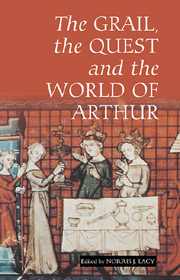Book contents
- Frontmatter
- Contents
- List of Illustrations
- Notes on Contributors
- Foreword
- Introduction: Arthur and/or the Grail
- 2 The Shape of the Grail in Medieval Art
- 3 The Crusaders' Grail
- 4 Bounds of Imagination: Grail Questing and Chivalric Colonizing in Wolfram von Eschenbach's Parzival
- 5 The Land without the Grail: A Note on Occitania, Rigaut de Barbezieux and Literary History
- 6 Female Desire and the Quest in the Icelandic Legend of Tristram and Ísodd
- 7 Questing in the Middle Dutch Lancelot Compilation
- 8 Keeping Company: Manuscript Contexts for Reading Arthurian Quest Narratives
- 9 Grail and Quest in the Medieval English World of Arthur
- 10 Malory and the Grail: The Importance of Detail
- 11 Glastonbury, the Grail-Bearer and the Sixteenth-Century Antiquaries
- 12 The Grail Quest: Where Next?
- Appendix: The Grail on Film
- Index
- Analysis of grail scenes
- Arthurian Studies
2 - The Shape of the Grail in Medieval Art
Published online by Cambridge University Press: 05 February 2013
- Frontmatter
- Contents
- List of Illustrations
- Notes on Contributors
- Foreword
- Introduction: Arthur and/or the Grail
- 2 The Shape of the Grail in Medieval Art
- 3 The Crusaders' Grail
- 4 Bounds of Imagination: Grail Questing and Chivalric Colonizing in Wolfram von Eschenbach's Parzival
- 5 The Land without the Grail: A Note on Occitania, Rigaut de Barbezieux and Literary History
- 6 Female Desire and the Quest in the Icelandic Legend of Tristram and Ísodd
- 7 Questing in the Middle Dutch Lancelot Compilation
- 8 Keeping Company: Manuscript Contexts for Reading Arthurian Quest Narratives
- 9 Grail and Quest in the Medieval English World of Arthur
- 10 Malory and the Grail: The Importance of Detail
- 11 Glastonbury, the Grail-Bearer and the Sixteenth-Century Antiquaries
- 12 The Grail Quest: Where Next?
- Appendix: The Grail on Film
- Index
- Analysis of grail scenes
- Arthurian Studies
Summary
What exactly is the Grail and what shape does it have? Is it a dish, a bowl, a chalice, a ciborium or a stone? Is it made of wood, stone, silver or gold? The answers to these questions vary from text to text. In the numerous medieval literary works in which it appears, the Grail assumes many forms and functions. Most often the Grail is supposed to have been used by Christ during the Last Supper and to have been entrusted to Joseph of Arimathea, who used it to catch the blood flowing from the wounds of Christ at the Entombment. This sacred object usually has power as a provider of food; it heals the wounded and is surrounded by mystery.
The appeal of the Holy Grail is not confined to the Middle Ages. Not only does it play a major part in Dan Brown's best-selling murder mystery The Da Vinci Code, it also featured as the ultimate quest object in popular movies like Indiana Jones and the Last Crusade. This movie even includes a ‘Grail test’ towards the end, in which those who fulfilled the quest are subjected to one last trial: to choose the Grail from a huge variety of cups and chalices displayed on a table. The ‘Bad Guy’ makes the wrong choice; he selects the most beautiful chalice on the table, assuming that the Grail is the cup of a King of Kings, whereas Indiana Jones makes the right choice by choosing the most plain and simple cup, one befitting a carpenter.
- Type
- Chapter
- Information
- The Grail, the Quest, and the World of Arthur , pp. 13 - 27Publisher: Boydell & BrewerPrint publication year: 2008



